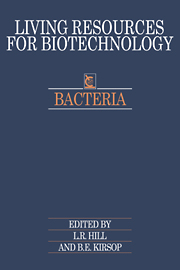Book contents
4 - Culture and maintenance
Published online by Cambridge University Press: 04 August 2010
Summary
Culture
The variety of nutritional requirements covering the whole spectrum of known bacteria is wide, and aspects of initial culture of bacteria that will be considered here will be restricted to those relating to the subsequent process of diverse preservation techniques. Reference should be made to standard textbooks for information on how best to grow different species, details of media formulations, pH, gaseous conditions and optimum incubation temperatures and times. However, a number of general factors must be borne in mind regarding culture for preservation.
Primary isolation
An obvious first requirement is to ensure that the culture is pure. Wherever practicable, the use of solid media is to be preferred to liquid media, since these allow plating out and subsequent single-colony isolations. In medical bacteriology, one plating out and single-colony isolation is usual for immediate investigations (for example, identification or determination of antibiotic sensitivity), where speed of obtaining an answer is the over-riding factor. For less urgent requirements and for preservation, however, it is advisable to go through two or even three successive platings out and single-colony isolations to ensure purity of the culture.
Enrichment
Primary isolation may sometimes be preceded by enrichment of the source material and usually this will be done in liquid media. Indeed, liquid media may be essential if the required bacterium requires, for example, good aeration or fluxing with special gases. Plating out from appropriate dilutions will yield single colonies and again, wherever practicable, further culture should be carried out on solid media.
- Type
- Chapter
- Information
- Bacteria , pp. 62 - 80Publisher: Cambridge University PressPrint publication year: 1991

